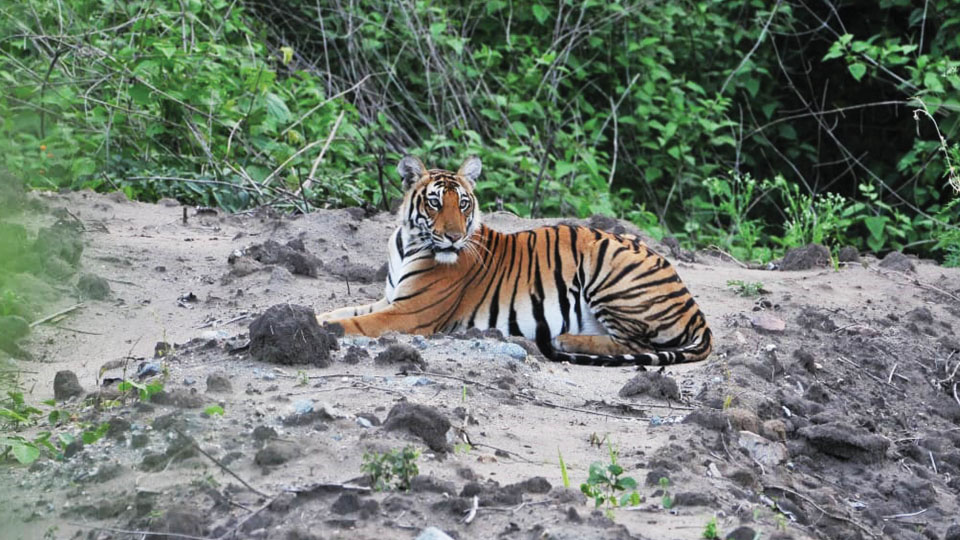With 149 big cats, Nagarahole Tiger Reserve pips Bandipur Tiger Reserve with 140 tigers
Bengaluru/Mysuru: The tiger count in Karnataka has shown an impressive increase, with a minimum of 435 tigers as per the All India Tiger Estimation (AITE) exercise conducted in 2022, compared to 404 tigers estimated during the 2018 AITE exercise — a gain of 31.
Eshwar B. Khandre, Minister of Forest, Ecology and Environment, attributed this significant rise in tiger numbers to various conservation initiatives. The Minister disclosed the AITE details on July 27, just two days ahead of International Tiger Day.
As per the guidelines of the National Tiger Conservation Authority (NTCA), a tiger census (AITE) is conducted once every four years, during which a census of elephants, carnivores and herbivores is also carried out nationwide. Claiming the coveted position of the national park with the highest number of tigers is the Nagarahole Tiger Reserve, surpassing the Bandipur Tiger Reserve. While Bandipur Tiger Reserve houses 140 tigers, Nagarahole Tiger Reserve boasts a population of 149 tigers.
373 tigers in five Tiger Reserves
Additionally, Bhadra, Kali and Biligiri Ranganathaswamy Tiger Reserve are home to 26, 19 and 39 tigers, respectively. Together, these five tiger reserves in Karnataka account for 373 tigers out of the total 435. Officials have mentioned that the final estimate will be provided in the NTCA report, which is expected to be released today, July 29.
Nagarahole has experienced a steady increase in tiger numbers since 2014, when there were 72 tigers. This number escalated to 125 in 2018 and further to 149 in 2022. Notably, the Tiger Reserve also boasts the highest tiger density, with 10.88 tigers per square kilometre, compared to Bandipur’s 7.97 tigers per square kilometre. The tiger census during 2021-22 was conducted scientifically and comprehensively in all 37 wildlife sanctuaries, with tiger presence noted in 22 divisions. This census utilised camera trap and line transect methods.
Approximately 5,399 camera traps were installed in all protected forests, capturing 66,86,450 photographs of wild animals, which were then analysed to calculate the tiger population based on their movements and territorial boundaries using modern technology.
From 404 to 435 tigers
The Forest Department maintains a database of photo-captured tigers, including information on age, gender, territory and dispersal patterns. This database plays a crucial role in conflict management and identifying injured or deceased tigers.
The 2018 All India Tiger Census indicated 404 tigers in camera traps conducted in Karnataka, and after analysing wildlife statistics, it was estimated that there might be 475 to 573 tigers in the State. The 2022 census, however, revealed 435 tigers and experts believe this number may continue to increase.
Notably, several camera points were installed in different tiger reserves, such as 612 in Bandipur Tiger Reserve, 330 in Bhadra, 288 in BRT, 448 in Kali and 502 in Nagarahole, leading to the discovery of 376 unique tigers.
Other big cat presence
The rest of the big cats are dispersed across various protected areas that are not designated as tiger reserves. According to the report, there are seven tigers in the Belagavi Forest division, six in Chikkamagaluru division, 11 in Madikeri division and five in Bhadravathi division.
In addition to these divisions, tiger presence has also been observed in Cauvery Wildlife Sanctuary (2 tigers), Kudremukh (2 tigers), Mysuru (4 tigers), Yellapura (2 tigers), Koppa (6 tigers), Bannerghatta (2 tigers), Karwar (1 tiger) and Haliyal (1 tiger).
These regions contribute to the overall tiger population in Karnataka, showcasing the State’s commitment to preserving and protecting these majestic creatures in multiple areas beyond the designated tiger reserves.
M.M. Hills not yet a Tiger Reserve
It’s worth noting that M.M. Hills Wildlife Sanctuary, whose tiger reserve status has been kept in abeyance, has a minimum of five tigers. However, officials believe that the actual count at M.M. Hills is higher as the current figures are based solely on camera-trapped images.
Although the proposal to declare M.M. Hills Wildlife Sanctuary as a Project Tiger Reserve was cleared more than two years ago, the final notification is still pending with the State Government. In fact, the Cauvery Wildlife Sanctuary is connected to M.M. Hills Wildlife Sanctuary and Sathyamangalam Tiger Reserve in Tamil Nadu.








Recent Comments